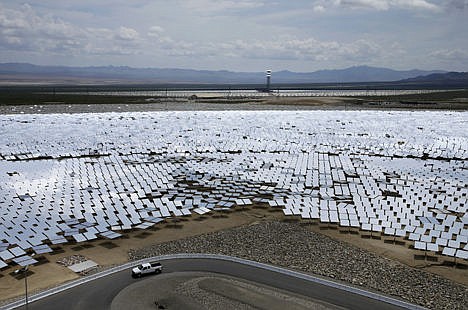Solar power plants scorch birds in mid-air
IVANPAH DRY LAKE, Calif. (AP) - Workers at a state-of-the-art solar plant in the Mojave Desert have a name for birds that fly through the plant's concentrated sun rays - "streamers," for the smoke plume that comes from birds that ignite in midair.
Federal wildlife investigators who visited the BrightSource Energy plant last year and watched as birds burned and fell, reporting an average of one "streamer" every two minutes, are urging California officials to halt the operator's application to build a still-bigger version.
The investigators want the halt until the full extent of the deaths can be assessed. Estimates per year now range from a low of about a thousand by BrightSource to 28,000 by an expert for the Center for Biological Diversity environmental group.
The deaths are "alarming. It's hard to say whether that's the location or the technology," said Garry George, renewable-energy director for the California chapter of the Audubon Society. "There needs to be some caution."
The bird kills mark the latest instance in which the quest for clean energy sometimes has inadvertent environmental harm. Solar farms have been criticized for their impacts on desert tortoises, and wind farms have killed birds, including numerous raptors.
"We take this issue very seriously," said Jeff Holland, a spokesman for NRG Solar of Carlsbad, California, the second of the three companies behind the plant. The third, Google, deferred comment to its partners.
The $2.2 billion plant, which launched in February, is at Ivanpah Dry Lake near the California-Nevada border. The operator says it's the world's biggest plant to employ so-called power towers.
More than 300,000 mirrors, each the size of a garage door, reflect solar rays onto three boiler towers each looming up to 40 stories high. The water inside is heated to produce steam, which turns turbines that generate enough electricity for 140,000 homes.
Sun rays sent up by the field of mirrors are bright enough to dazzle pilots flying in and out of Las Vegas and Los Angeles.
Federal wildlife officials said Ivanpah might act as a "mega-trap" for wildlife, with the bright light of the plant attracting insects, which in turn attract insect-eating birds that fly to their death in the intensely focused light rays.
Federal and state biologists call the number of deaths significant, based on sightings of birds getting singed and falling, and on retrieval of carcasses with feathers charred too severely for flight.

